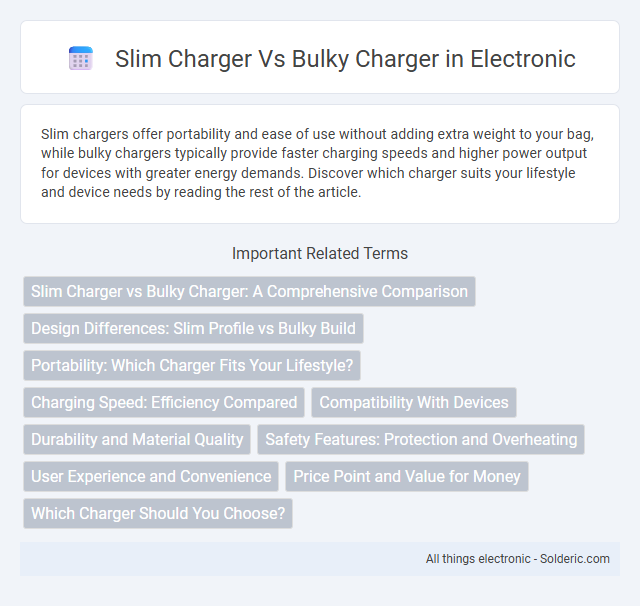Slim chargers offer portability and ease of use without adding extra weight to your bag, while bulky chargers typically provide faster charging speeds and higher power output for devices with greater energy demands. Discover which charger suits your lifestyle and device needs by reading the rest of the article.
Comparison Table
| Feature | Slim Charger | Bulky Charger |
|---|---|---|
| Size | Compact, lightweight | Large, heavy |
| Portability | Highly portable, easy to carry | Less portable, bulky to transport |
| Charging Speed | Moderate to fast, depending on wattage | Typically faster with higher wattage |
| Power Output | Usually 18W to 30W | Often 45W and above |
| Heat Dissipation | Limited, may get warm quickly | Better heat management |
| Durability | Less robust due to smaller size | More durable and sturdy |
| Price | Generally affordable | Usually more expensive |
Slim Charger vs Bulky Charger: A Comprehensive Comparison
Slim chargers offer portability and ease of use with lightweight designs that enhance convenience for travel and daily carry, while bulky chargers provide higher power output and faster charging speeds suitable for heavy-duty devices. Your choice depends on balancing the need for compactness with the requirement for charging performance, as slim chargers prioritize space-saving and bulky chargers emphasize functionality and power capacity. Devices like laptops and tablets may benefit more from bulky chargers due to higher wattage demands, whereas smartphones and small gadgets often charge efficiently with slim chargers.
Design Differences: Slim Profile vs Bulky Build
Slim chargers feature a compact design with a thin profile that enhances portability and saves space, making them ideal for travel or daily use. Bulky chargers, on the other hand, typically contain larger components and higher wattage, resulting in a heavier and more cumbersome build. Your choice depends on whether you prioritize convenience and sleekness or power and durability in your charging device.
Portability: Which Charger Fits Your Lifestyle?
Slim chargers offer unmatched portability due to their lightweight and compact design, making them ideal for users who travel frequently or prefer minimal bulk in their bags. Bulky chargers, while often providing higher power output and more charging ports, can be cumbersome and less convenient to carry daily. Your choice depends on whether you prioritize ease of transport or higher charging capacity to fit your lifestyle.
Charging Speed: Efficiency Compared
Slim chargers often utilize advanced power delivery technology that enables faster charging speeds despite their compact size. Bulky chargers may provide higher wattage output but can suffer from heat dissipation issues, reducing overall efficiency during prolonged use. Efficient power management in slim chargers results in optimized charging speed, making them preferable for quick device recharges.
Compatibility With Devices
Slim chargers offer broad compatibility with modern devices, supporting a wide range of voltage and current outputs suitable for smartphones, tablets, and laptops. Bulky chargers typically provide higher power capacity, making them ideal for devices requiring fast charging or heavy power consumption, such as gaming laptops and large tablets. Your choice should consider the specific power requirements of your devices to ensure optimal charging performance and safety.
Durability and Material Quality
Slim chargers often utilize high-quality, lightweight materials such as aluminum alloys and reinforced composites, enhancing durability while maintaining portability. Bulky chargers typically feature robust plastic or metal casings designed to withstand impact and prolonged use, providing strong resistance to wear and tear. Material quality in both types directly influences charger lifespan, with premium components reducing internal damage and improving heat dissipation.
Safety Features: Protection and Overheating
Slim chargers often integrate advanced safety features such as overcurrent, overvoltage, and short-circuit protection within compact designs, reducing risks of overheating and electrical damage. Bulky chargers typically have larger heat dissipation components and robust internal circuits that effectively manage thermal buildup but may lack the latest safety tech found in slimmer models. Choosing between slim and bulky chargers depends on balancing portability with proven protection mechanisms to ensure device safety and longevity.
User Experience and Convenience
Slim chargers offer enhanced user experience by being lightweight, portable, and easy to carry, making them ideal for travel and daily use. Bulky chargers, while often delivering higher power output, are less convenient due to their size and weight, which can cause hassle during transport and limit flexibility. The compact design of slim chargers reduces clutter and allows for easier cable management, significantly improving convenience for on-the-go users.
Price Point and Value for Money
Slim chargers often come at a higher price point due to advanced technology and compact design, offering excellent portability for users on the go. Bulky chargers generally provide greater power output and reliability at a lower cost, delivering value for money through durability and faster charging speeds. Your choice depends on whether you prioritize convenience and lightweight design or budget-friendly performance.
Which Charger Should You Choose?
Choosing between a slim charger and a bulky charger depends on your priorities for portability and charging speed. Slim chargers are lightweight and easy to carry, ideal for travel and everyday use, while bulky chargers often provide faster charging and higher wattage suitable for heavy-duty devices. Your decision should balance convenience with power needs to ensure optimal device performance.
slim charger vs bulky charger Infographic

 solderic.com
solderic.com